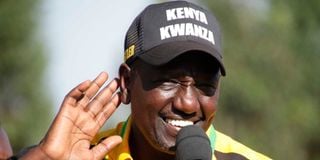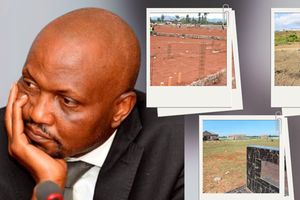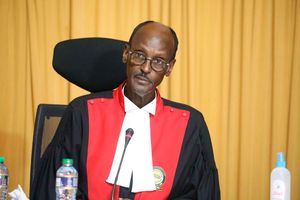Premium
On unity, economic model, competence and honesty, Ruto scores better than Raila

Deputy President William Ruto addresses wananchi at Giampampo Primary School in Tharaka Nithi County during a Kenya Kwanza Alliance campaign rally on March 12, 2022.
What you need to know:
- Ruto’s proposed interventions including providing cheap credit to the poor is, sound economically.
- Compare that with Raila’s proposal of providing Sh6,000 per month to the unemployed.
Kenyans will vote for a new president in about four months. On what basis will Kenyan voters decide how they will cast their ballot?
Several basic factors can be identified as reasons for choosing a candidate in a presidential election. They include orientations on specific issues of public policy, general evaluations of the government performance and evaluations of the personal characteristics of the candidates.
This article compares Azimio la Umoja leader Raila Odinga and UDA’s William Ruto, the leading contestants for the presidency. It compares the two candidate’s public policy agendas and their respective personal attributes.
Mr Odinga and Dr Ruto have given differing economic diagnosis and prognosis for Kenya’s problems. It is important this article settles the comparison standard. The starting point for the comparison of the two is to check Kenya’s position in United Nation's Human Development Index (HDI). The HDI is a summary measure for assessing various states’ long-term progress in three basic dimensions of human development: a long and healthy life, access to knowledge and a decent standard of living.
According to United Nation, Kenya’s latest HDI value is 0.601, positioning it at 143 out of 189 countries and territories. Therefore ,Kenya needs a leader with good economic thoughts to push its United Nation’s economic ranking .
Like all averages, the HDI masks inequality in the distribution of human development across the population at the country level. The 2010 Human Development Report introduced Inequality-adjusted HDI (IHDI), which takes into account inequality in all three dimensions of the HDI by ‘discounting’ each dimension’s average value according to its level of inequality.
The IHDI is basically the HDI discounted for inequalities. Kenya’s HDI for 2019 is 0.601. However, when the value is discounted for inequality, the HDI falls to 0.443, a loss of 26.3 per cent due to inequality in the distribution of the HDI dimension indices.
This data illustrates Kenya economic figures which President Uhuru Kenyatta often presents to show progress but mask great inequalities. Ruto’s bottom-up economic model solves this gap. His public policy agenda seeks to remedy Kenya’s economic inequalities by proposing to uplift those at the bottom of the pyramid.
Cheap credit to Kenyans
Ruto’s proposed interventions including providing cheap credit to the poor is, therefore, sound economically. Compare that with Raila’s proposal of providing Sh6,000 per month to the unemployed. Despite its good intentions, this proposal would spur inflation due to an increase of money supply in the market.
In economics, inflation refers to a general progressive increase in prices of goods and services in an economy. When the general price level rises, each unit of currency buys fewer goods and services; consequently, inflation corresponds to a reduction in the purchasing power of money.
Other negative effects of Raila proposal include an increase in the opportunity cost of holding money, uncertainty over future inflation which may discourage investment and savings, and if inflation were rapid enough, shortages of goods as consumers begin hoarding out of concern that prices will increase in the future.
In summary, Ruto thoughts are supply side economics while Raila thoughts are demand side economics. Ruto has correctly diagnosed root causes of Kenya’s economic problems , which are, inadequate supply of goods and services.
Ruto, therefore, proposes to provide cheap credit to more Kenyans so that they can make more goods and services hence create more employment. This will also make goods and services cheaper in the market due to an expansion of supply. On the other hand, Raila proposal is to increase demand without making effort to increase supply of goods and services. The net effect is inflation.
The second lenses for comparing Ruto and Raila is checking their thoughts on political development of Kenya. For the purposes of this article, political development is defined as domestic attributes of constitutional order and political stability.
Political development enhances the state's capacity to mobilise and allocate resources, to process policy inputs into implementable outputs. This assists with problem-solving and adaptation to environmental changes and goal realisation. The contemporary notion of good governance also dwells on efficient, effective, and non-corrupt public administration.
Raila and Ruto thoughts on political development of Kenya are best discerned by checking their views on Building Bridges Initiative (BBI) .Raila was BBI best advocate and Ruto was its key opponent. Without prejudice to legal arguments pending determination in court, Raila did not make a convincing case in the court of public opinion on why he supported a document that proposed to erode gains in 2010 constitution particularly on matters touching Judiciary.
Fostering ethnic divisions
The document proposed to seriously encroach on the cherished independence of Judiciary by introducing the Office of Ombudsman. The 2010 constitution decreed establishment of a Judicial fund for its independence. It is only Ruto who has made a public pledge to operationalise the fund .
The enduring problem of political development for some divided societies like Kenya, remains how to combine political stability with political liberalisation and democratisation. The contrasting approaches of the two leaders on this issue can be discerned by checking their political formations and narratives as Kenya approaches elections.
Raila has created an umbrella political formation called Azimio comprising ethnic parties. Jubilee is being championed as a Kikuyu party; DAP K as western party ; UPIA as a North Eastern party and Wiper as a Kamba party. Ruto has endeavoured to build a national outfit called UDA off course with minor exception of ANC and Ford Kenya.
In a nutshell, Raila is fostering ethnic divisions while Ruto is pulling Kenyans towards a common and united cause. On political narration, Ruto has coined a unifying clarion call of ‘hustler nation’ which transcends tribes and regions. This narrative is finding acceptance beyond his regional base of Rift Valley. Raila is yet to conjure a nationalistic rhetoric that goes beyond tribal and regional bases.
This article now turns to the second criterion of comparing their personal attributes. Voters also judge candidates by their personal characteristics. Included among the relevant characteristics are such things as the experience, honesty, morality, compassion, competence, and leadership ability of the candidates.
Apart from how they see the candidates on the issues, voters form images of the personal qualities and abilities of the candidates, and these perceptions are important influences on the vote. One important aspect of personal character is the perceived honesty and trustworthiness of the candidates – what might be termed an integrity dimension.
Another important dimension, which might be termed competence, involves the experience and knowledge of the candidates. In particular, voters are hardly likely to vote for someone whom they feel lacks the experience and ability to handle the job of president. A third important dimension involves the leadership ability of the candidates.
Those who are perceived as strong and inspiring leaders are much more likely to be preferred by the voters. Finally, there is a compassion dimension; voters favour candidates whom they see as concerned and caring. These four dimensions of personal traits may vary in their importance; perhaps one or more of the dimensions will have little effect in any given election.
Honouring agreements
From a honesty and trustworthiness perspective, Raila disagreed acrimoniously with the late President Moi in 2002 despite originally forming an alliance in 1999. Raila disagreed acrimoniously with Kibaki in 2004 after a confidential Memorandum of understanding was purportedly breached.
Kalonzo Musyoka has publicly accused Raila of dishonesty after he alleged Raila broke an agreement to support him irrespective of electoral outcome in 2017. Mudavadi has accused Raila’s party of failing to remit monies owing to ANC for the period between 2017-2022.
On the other hand, Ruto has a consistent record of honouring agreements. He supported Uhuru four times – 2002 ,2013 and twice in 2017 .He strongly supported Raila in 2007.This illustrates Ruto is a trustworthy person .
From a competence perspective, despite Raila’s best intentions, his age does not do Kenya justice. Kenya requires a younger leader to competently drive its agenda forward. Presidency is a full-time engagement which requires stamina and energy best demonstrated by Ruto’s vigorous campaigns.
Without being accused of ageism, Kenyans need to ask themselves, which candidate can best respond to that urgent, important 2am phone call with speed and good judgment? How on the campaign trail, in the debates and at work, has the candidate shown himself or herself to be mentally and physically healthy enough to be president? Has the candidate shown an ability to connect with all generations?
Further, on matters competence, Ruto has served various portfolios with distinction. As agriculture minister, he pushed for the lowering of fertiliser prices to record low. As minister for higher education, Ruto reduced public university admission waiting period from two years to five months. Raila best credentials are in fighting for democracy. Though important, Kenya at this stage does not require a fighter. It requires a performer.
On this competence measure, Ruto defeats Raila.
Dr Kang’ata teaches law at Catholic University of Eastern Africa.He has served as councilor, MP and senator





